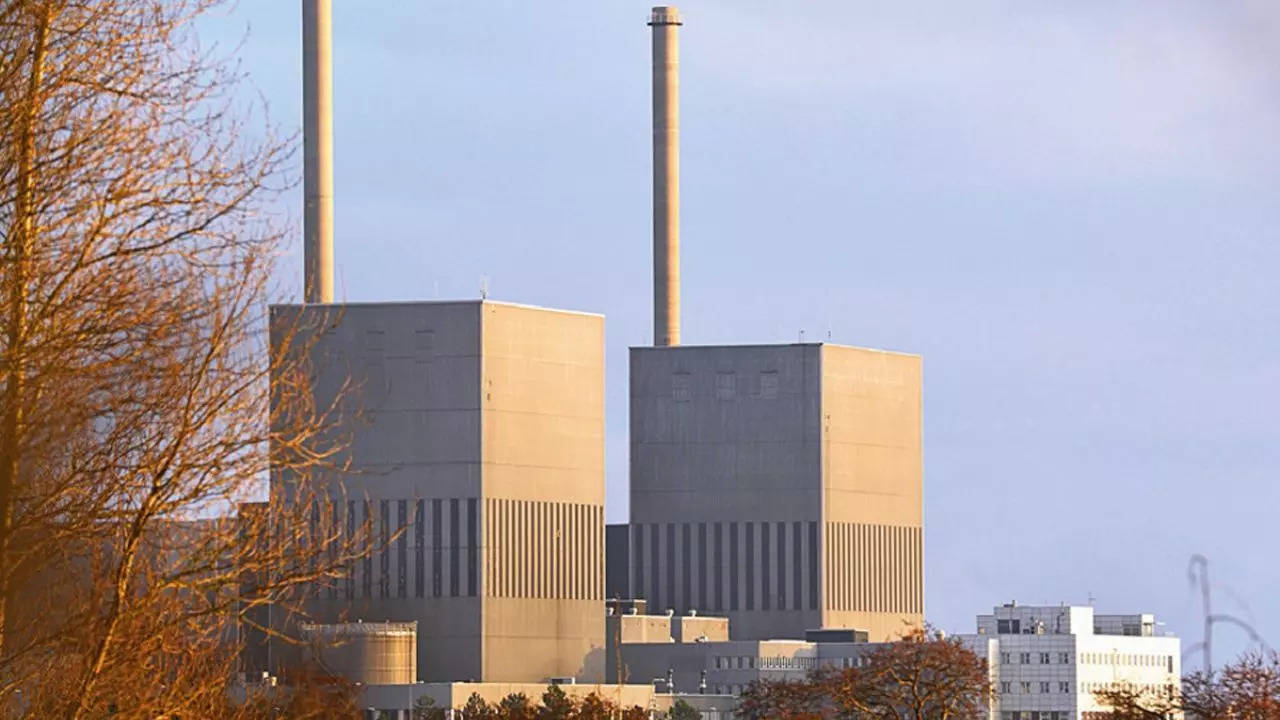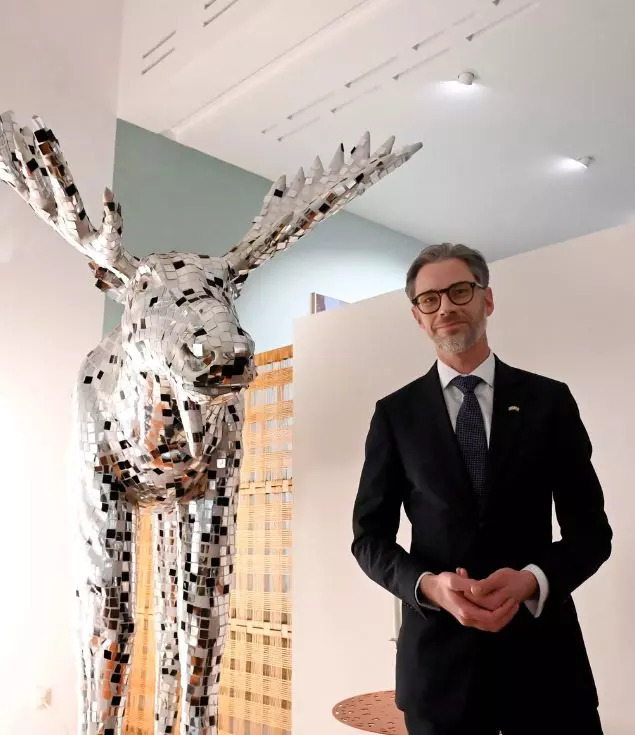‘Nuclear energy is essential to end fossil fuel use — India’s solar power rise is impressive’
 VIABLE WAY FORWARD? Nuclear power seems daunting — but Sweden has used it since the 1970s, enabling lower foss... Read More
VIABLE WAY FORWARD? Nuclear power seems daunting — but Sweden has used it since the 1970s, enabling lower foss... Read MoreDaniel Westlénis Sweden’s State Secretary, the Ministry of Climate and Enterprise. Visiting India, he spoke to Srijana Mitra Das at Times Evokeon energy — in an era of climatic and geopolitical risks:
Please tell us about your visit to India?
We’re here for a Joint Working Group meeting with the Ministry of Environment, Forest and Climate Change in Delhi. We’ve had a Memo-randum of Understanding with India since 2009 on the environment. Sweden and India collaborate on knowledge transfers, education and development, for instance, looking at ways to make fossil-free steel. India and Sweden founded the LeadIT Program, the Leadership Group for Industry Transition, which has 18 countries cooperating on lowering emissions in steel, cement, etc.
We currently use hydropower and a nuclear program which began in the 1970s. We’ve had fossil free electricity since then and we could close our oil power plants. We use some fossil fuels in reserve capacity to restart the grid upon outages- otherwise, this is fossil-free. We electrified much of our industry early, so emissions there are low. We use fossil fuels in some sectors, like steel, transport and agriculture. No-one’s solved farming yet but we’re trying to reduce carbon dioxide and methane emissions. This means talking to many farmers instead of a few business leaders — and in an economy which must stay competitive.

Is Sweden feeling global warming?
Yes. Temperatures are increasing fast — and faster in the north than the global average. We have shorter winters and less snow now — insects and birds are unable to synchronise and produce food. Climate zones are moving upwards as well — so, our conservation is changing. To save a bird species, we’ll preserve an entire stretch of forest in the north-south direction, so birds can move along the line. We’re also seeing droughts— and with our dense forests, as the weather warms, Sweden has wildfires now.
Why did you opt for nuclear energy?
We started developing civil nuclear power right after it was discovered, establishing a test reactor in 1954. There are only three ways of producing fossil-free energy at scale to meet the modern world’s requirements — solar, wind and nuclear. Replacing fossil fuels in electricity is relatively easy for, say, the first 50% of consumption but then, it grows harder to balance the grid and provide power during low sunshine or wind. Some nations use gas as the dispatchable part of the system — but to reach net zero, you can’t do that. To eliminate fossil fuels, unless hydropower is expandable, nuclear energy is essential.

What about its safety?
I’m a nuclear engineer by training and I think the biggest mistake the industry made was talking about safety so much. They’ve been making the sector safer, guarding all probabilities, since the first reactors started while the regulations imposed on this industry are not comparable to anything else. We’ve been building a spent fuel repository in Sweden— its safety level is defined as people living near it, even in the distant future, not getting radiation amounts higher than what they would at the dentist’s. Air pollution has greater risks than nuclear plants. Around 70% of Sweden’s population supports such energy — that’s higher among people living by these plants as they see the safety protocols maintained. Instead of risks, we should discuss the benefits of nuclear power.
Sweden has phased out most coal —can it offer India insights?
Our coal was largely imported, so there was a good reason to phase it out. In industry, this was replaced with electricity and biomass. For heating, we use biomass and fuel generated from waste. India uses coal mainly for electricity — as mentioned, there are only three ways to replace fossil fuels at scale. India is doing extremely well in solar power — it has made great strides and is reducing costs too. Solar and wind are weather-dependent though — so, nuclear energy is important. India has a very impressive nuclear program — it could help phase out coal.

Sweden faces new geopolitical threats— do these influence energy?
We aren’t at war — but we aren’t at peace. We are exposed to hybrid attacks, like the Russian shadow fleet where oil moves through the Baltic— with sanctions in place, poorly-maintained tankers are used in one of the world’s most sensitive waterbodies and oil spills are a huge worry. When the Ukraine crisis began, Germany had to phase out Russian gas — a scarcity developed in Europe. Sweden uses very little gas but our electricity prices increased because we had to export to the continent. This was a major energy crisis, com-parable to the oil crisis of the 1970s. We often discuss an ‘energy triangle’, which is the environmental impacts of energy policies, their economics and geopolitics, including security where opponents can’t weaponise energy — with Ukraine, the geopolitical aspect of energy has returned.

How do you view Greenland vs the US?
Greenland’s future is upto the Greenlanders and Denmark — we support our neighbouring country. We don’t want anybody to move national borders using threats or military force. It’s not acceptable from Russia — or anyone else.
(Views expressed are personal)
Times Evoke Diplomaticus is an occasional series on climate, energy and geopolitics

Please tell us about your visit to India?
We’re here for a Joint Working Group meeting with the Ministry of Environment, Forest and Climate Change in Delhi. We’ve had a Memo-randum of Understanding with India since 2009 on the environment. Sweden and India collaborate on knowledge transfers, education and development, for instance, looking at ways to make fossil-free steel. India and Sweden founded the LeadIT Program, the Leadership Group for Industry Transition, which has 18 countries cooperating on lowering emissions in steel, cement, etc.
What are Sweden’s energy challenges?
We currently use hydropower and a nuclear program which began in the 1970s. We’ve had fossil free electricity since then and we could close our oil power plants. We use some fossil fuels in reserve capacity to restart the grid upon outages- otherwise, this is fossil-free. We electrified much of our industry early, so emissions there are low. We use fossil fuels in some sectors, like steel, transport and agriculture. No-one’s solved farming yet but we’re trying to reduce carbon dioxide and methane emissions. This means talking to many farmers instead of a few business leaders — and in an economy which must stay competitive.

Is Sweden feeling global warming?
Yes. Temperatures are increasing fast — and faster in the north than the global average. We have shorter winters and less snow now — insects and birds are unable to synchronise and produce food. Climate zones are moving upwards as well — so, our conservation is changing. To save a bird species, we’ll preserve an entire stretch of forest in the north-south direction, so birds can move along the line. We’re also seeing droughts— and with our dense forests, as the weather warms, Sweden has wildfires now.
Why did you opt for nuclear energy?
We started developing civil nuclear power right after it was discovered, establishing a test reactor in 1954. There are only three ways of producing fossil-free energy at scale to meet the modern world’s requirements — solar, wind and nuclear. Replacing fossil fuels in electricity is relatively easy for, say, the first 50% of consumption but then, it grows harder to balance the grid and provide power during low sunshine or wind. Some nations use gas as the dispatchable part of the system — but to reach net zero, you can’t do that. To eliminate fossil fuels, unless hydropower is expandable, nuclear energy is essential.

What about its safety?
I’m a nuclear engineer by training and I think the biggest mistake the industry made was talking about safety so much. They’ve been making the sector safer, guarding all probabilities, since the first reactors started while the regulations imposed on this industry are not comparable to anything else. We’ve been building a spent fuel repository in Sweden— its safety level is defined as people living near it, even in the distant future, not getting radiation amounts higher than what they would at the dentist’s. Air pollution has greater risks than nuclear plants. Around 70% of Sweden’s population supports such energy — that’s higher among people living by these plants as they see the safety protocols maintained. Instead of risks, we should discuss the benefits of nuclear power.
Sweden has phased out most coal —can it offer India insights?
Our coal was largely imported, so there was a good reason to phase it out. In industry, this was replaced with electricity and biomass. For heating, we use biomass and fuel generated from waste. India uses coal mainly for electricity — as mentioned, there are only three ways to replace fossil fuels at scale. India is doing extremely well in solar power — it has made great strides and is reducing costs too. Solar and wind are weather-dependent though — so, nuclear energy is important. India has a very impressive nuclear program — it could help phase out coal.

Sweden faces new geopolitical threats— do these influence energy?
We aren’t at war — but we aren’t at peace. We are exposed to hybrid attacks, like the Russian shadow fleet where oil moves through the Baltic— with sanctions in place, poorly-maintained tankers are used in one of the world’s most sensitive waterbodies and oil spills are a huge worry. When the Ukraine crisis began, Germany had to phase out Russian gas — a scarcity developed in Europe. Sweden uses very little gas but our electricity prices increased because we had to export to the continent. This was a major energy crisis, com-parable to the oil crisis of the 1970s. We often discuss an ‘energy triangle’, which is the environmental impacts of energy policies, their economics and geopolitics, including security where opponents can’t weaponise energy — with Ukraine, the geopolitical aspect of energy has returned.

How do you view Greenland vs the US?
Greenland’s future is upto the Greenlanders and Denmark — we support our neighbouring country. We don’t want anybody to move national borders using threats or military force. It’s not acceptable from Russia — or anyone else.
(Views expressed are personal)
Times Evoke Diplomaticus is an occasional series on climate, energy and geopolitics

Download
The Times of India News App for Latest India News
Subscribe
Start Your Daily Mornings with Times of India Newspaper! Order Now











All Comments ()+^ Back to Top
Refrain from posting comments that are obscene, defamatory or inflammatory, and do not indulge in personal attacks, name calling or inciting hatred against any community. Help us delete comments that do not follow these guidelines by marking them offensive. Let's work together to keep the conversation civil.
HIDE